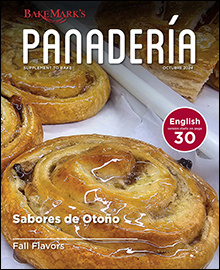The COVID-19 pandemic continues to impact sales for local businesses across the state of Ohio. For Hispanic bakeries in the area, they are adapting to the new realities of doing business and making the best of their circumstances.
At Panadería La Mexicana, a bustling bakery in Fairfield, Ohio, Luis Leon says their business has accelerated daily procedures for cleaning and disinfecting the workspaces. Customers feel safe, and they are more aware of how to protect themselves while in the bakery. His father Adalberto Leon owns the bakery business.
In addition, the bakery has expanded its reach by selling to more grocery stores and supermarkets, including a new deal with a large hypermarket with three locations in Ohio.
“We want to get in front of more people so they will try our breads,” Leon says. “If people feel safer going to bigger supermarkets, that is where we want to be.”
The reality is that supermarket sales have risen 5% or more across the country in the wake of the pandemic, as consumers shop more at grocery stores for important staples such as breads and pastries.
In April, during the height of the shelter-at-home orders, 37% of consumers told NPD they wanted to make sure they had sufficient breads and snack foods on hand. Also, in many cases, the more snack food in the home, the more frequently the item is consumed, which tends to be especially true of certain types of breads and snack foods.
“We’ve seen consumers turn to indulgent snack foods in other challenging times, and although history isn’t repeating itself during COVID, it is rhyming,” says Darren Seifer, NPD food and beverage industry analyst. “Although we can’t predict what’s going to happen in the future, I think it’s safe to say snack food manufacturers and retailers can expect elevated snack food usage while COVID-19 restricts our restaurant usage and overall movement, in particular school closings and work from home orders.”
Consumers have historically turned to snack foods for comfort and enjoyment during challenging times, like the Great Recession, but this behavior has been heightened during the COVID-19 pandemic, reports The NPD Group. Given both the economic and well-being stressors related to COVID-19, indulgent snacking is playing an even more important role during these current challenging times.
New spins
The instore bakery department has “yet to return to normal,” said Todd Hale, principal at Cincinnati-based Todd Hale LLC, noting this part of the business has underperformed during the crisis. This department can make progress through new spins on popular pre-COVID-19 trends, he added.
“There had been a lot of demand for single-serve items like bagels or cookies. So how about more packaged single-serve?”
Hale sizes up the state of the baking industry by leveraging Nielsen data and providing his perspectives, with points including the following:
- Food Retail: Supermarkets and value-focused retailers have been driving the most growth over the past 52 weeks, up 11.9% and 7.8%, respectively.
- Economy: The economy remains challenging, and there is greater inflationary pressure from food at home. If the economy worsens, many shoppers will likely cook more at home and seek more savings strategies.
- Grocery: The grocery department has dominated year-to-date bread and baked good sales, accounting for $40.8 billion of the total $55.8 billion in this segment across the store —as the fresh bakery department continues to suffer.
- Categories: The pandemic has reminded consumers of the benefits of the commercial bread aisle, but refrigerated and frozen bread and baked goods are growing faster.
- Restaurants: The restaurant business is likely to encounter challenges for at least another six months, with mixed impacts on the quick-serve sector and severe implications for upscale segments.
- Demand: Food retailers and manufacturers are already preparing for the possibility of another COVID surge, including stockpiling groceries to be ready for rising demand.
Nielsen research found 29% of consumers are worse off financially compared to last year, and only 37% are secure in their jobs.
“This explains why so many observers are now talking about a K-shaped economic recovery,” Hale said, which suggests different impacts by consumer groups — in particular, a haves and have-nots scenario. “The haves will be okay, so premium products will probably be good,” Hale said. “For those struggling to spend, the value retail players have a chance to fill demand.”
Consumers are unlikely to completely abandon their new home-based behaviors when the COVID-19 crisis is over, Hale predicted, referring to at-home baking and cooking.
“I don’t think people will become weary of cooking and entertaining at home,” he said. “It will continue to be a growth engine. I would suggest more advertising that helps continue to fill demand around the enjoyment of eating at home and family togetherness.”
Hale urged bakers to make investments that position their businesses for the future, despite near-term challenges. “Don’t sit on the sidelines and think you can win,” he said. “Companies that invest during a recession come out ahead.”





